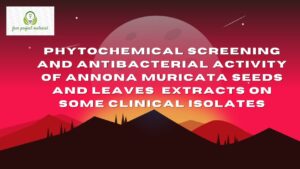ABSTRACT
This study was aimed at determining the phytochemistry and antibacterial activities of chewing stick and toothpaste on the microbiome of buccal cavity of students in Akwa Ibom State Polytechnic. Standard aseptical methods were employed in carrying out the analysis. The result of the study revealed the following; chewing stick sample contained, Alkaloids, Tannins, Flavonoids, and cardiac glycosides in moderate amount, while in the toothpaste contains Saponins, Tannins, and Cardiac glycosides in abundant amount, flavonoids in moderate amount and Alkaloids in trace amount. The morphological and biochemical characteristic of the bacterial isolates revealed the presence of Leptorichia sp, Fusobacterium sp and Peptococcus sp. Fusobacterium sp had the highest with 47% while Peptococcus sp had the least with 23%. The antibacterial activity of the toothpaste and the chewing stick revealed that Leptotrichia sp was sensitive to toothpaste and ethanolic extract of chewing stick while Fusobacterium sp and Peptococcus sp were resistant to both toothpaste and chewing stick extract. This indicate that chewing stick and toothpaste possess some antimicrobial properties even though the activities were poor. Therefore, it is recommended that chewing stick alone is not enough for maximum oral protection against microbial agents, toothpaste also be used in combination. Also, merasures should be put in place to thoroughly check for the efficacy of all the toothpastes sold within the country to ensure they are all effective against pathogenic Toothpaste bacteria.
TABLE OF CONTENTS
Title Page – – – – – – – – – i
Declaration – – – – – – – – – ii
Certification – – – – – – – – – iii
Dedication – – – – – – – – – iv
Acknowledgement – – – – – – – – v
Abstract – – – – – – – – – vi
Table of Contents – – – – – – – – vii
CHAPTER ONE: INTRODUCTION
1.1 Background of study – – – – – – 1
1.2 Aim and objective of the study – – – – – 5
1.3 Scope and Limitation of the study – – – – 6
CHAPTER TWO: LITERATURE REVIEW
2.1 Development of oral microbiome – – – – 7
2.2 Composition of the oral microbiome – – – – 9
2.3 Non-bacterial members of oral microbiome – – – 10
2.4 Function of the oral microbiome – – – – 11
2.5 Phytochemicals – – – – – – – 12
2.5.1 Phenolic acid – – – – – – – 12
2.5.2 Flavonoids – – – – – – 13
2.5.3 Tannins – – – – – – – – 14
2.5.4 Alkaloids – – – – – – – – 15
2.5.5 Saponins – – – – – – – – 16
2.6 Mechanisms of action and resistance of antibiotics – – 17
CHAPTER THREE: MATERIALS AND METHODS
3.1 Materials used – – – – – – – 19
3.2 Methods – – – – – – – – 19
3.2.1 Sterilization of glasswares – – – – – 19
3.2.2 Cultivation of Microorganisms – – – – – 20
3.2.3 Enumeration of Bacterial Isolates – – – – 20
3.2.4 Cultivation of Microorganisms – – – – – 20
3.2.5 Preparation of Stock Culture – – – – – 20
3.2.6 Characterization and Identification of Bacterial Isolates – 21
3.3 Antibacterial Susceptibility Test – – – – – 21
3.3.1 Preparation of Antibiotic Sensitivity Disc/Testing – – 21
3.4 Phytochemical Screening of Unripe Plantain Sap – – 22
CHAPTER FOUR: RESULT AND DISCUSSION
4.1 Results – – – – – – – – 23
4.2 Discussion – – – – – – – – 29
CHAPTER FIVE: CONCLUSION AND RECOMMENDATIONS
5.1 Conclusion – – – – – – – – 34
5.2 Recommendations – – – – – – – 34
References
CHAPTER ONE
1.0 INTRODUCTION
1.1 Background of the Study
The use of chewing sticks is deeply rooted in many cultures in the world. Chewing sticks has different societies. In Tanzania and Pakistan, it is called “miswak” while in Saudi Arabia and the middle east, it is called Arabic’s. it is known as ‘datar’ in india. (Almas, 1995; Igile, 1992). Hollist (2004), stated that chewing sticks are regularly used for cleaning: teeth by the Yoruba people of the south western part of Nigeria. these chewing sticks are obtained from roots and stems of some trees or plant
Akande and Hayashi (1998) reported that some of the chewing sticks being used are obtained from the following plants; Germania, manni, Masularia accuminita, Terminalia glauccescens, Anogeissus leiocarpus, Pseudocedrela kotschyi, Xanthoxyllum gilletti and Azadiracta Indica: Many studies have demonstrated the antimicrobial, anticaries, ant periopathic and anti-fungal properties of both aqueous and ethanolic extracts of various chewing sticks (Buada and Boak – Yiadom, 1973; Rotimi et al., 1988; Akande and Hayashi, Ogunsiya et al., 2000’) Adekunele and Odukoya, 2001; Ogundiya et al., 2006)
For alternative productions, plant used for antibiotics are justified. Medical plant are rich source of wide variety of secondary metabolites belonging to chemical classes such as sterols, alkaloids, glycosides, saponins, flavonoids, tannins, and carbohydrates ate generally superior int their ant-microbial activities (Cowan, 1999) leaves and flower of experimental plants have been used in the treatment of different variety of infection and disease. Chewing sticks on the other hand is a very important plant tree in Africa, most especially in Nigeria. The chewing sticks are used for three reasons, first, for cleaning of teeth and gums, second, to source of medicinal plants. The choice of chewing sticks to be used in most cases depends on its cleansing action of the teeth; the therapeutic value, or preferred taste or Flavour. The sticks (which maybe stem or root with and washed thoroughly with fresh water to get rid of the earth or any dirt.
The diameter should afford good grip say between 0.5-1.30cm. Akande and Hayashi (1998) reported that some of the chewing stick being used are obtained from the following plants: – Garcinia manni, Masularia accuminita, Terminalia glaucescens, Anogeissus elocarpus, Pseudocedrela kotschi, Xanthoxyllum guletti and Azadiracta indica. Investigations carried on some of these chewing sticks showed that they possess antimicrobial activity oral microbial flora such as staphylococcus aureus and S. auricularis (Akande and Hayashi 1998). Candida albican, Aspergillus flavus, Microsporium gypselum and trichophyton metagrophytes (Adekunle and odukoya, 2006)
One of the common oral infections suffered by the human population today-is dental caries. It is a very harmful disease of the teeth Moses et al.,2011). It causes decay of the teeth by the degradation of the acids released by the fermentation of the food particles left on the teeth after eating (silk, 2014) Toothpasteacteria such as Streptococcus mutans, Lactobacillus acidophilus, Staphytococcus aureus, etic. Accumulate to form a thick whitish layer on the tooth known as dental plaque, by combing with the food remains and saliva (Marsh et al., 2011). The organism produces acid from the Fermented foods which causes destruction of the tooth surface and from holes and cavities in the teeth (Varkaik et al., 2011). One of the major factors contributing to teeth decay is Poor hygiene due to lack of proper understanding of dental carries, which has led to a rise in the prevalence of dental carries around the world. It treatment is expensive and requires the competence of highly skilled professionals (Tonetti et al., 2015). In developing countries where there is lack of dental care facilities for most people, it is important to educate them on dental care to promote traditional means of teeth cleaning in addition to conventional toothpaste, as an abrasive for the teeth, suppresses halitosis, and the active ingredients (fluoride), helps to prevent tooth decay and gum-disease known as gingitis (American Dental Association, 2010).
Although, before the use of toothpaste, early man was known to use miswak as natural hygiene tools for oral health, and equally elucidate certain natural chemical compounds contained in miswak which play important roles. In maintaining good hygiene (AL – Bayati et al., 2018). Currently, miswak extracts is now incorporated in tooth paste as both an active ingredient and as flavoring (Sudhir et al., 2018). Thus, this study is set to determine the efficacy of different toothpastes and chewing sticks, and to determine their antibacterial activities on selected bacteria isolated from the oral cavity as a way of preventing dental cares.
1.2 Aim and Objectives of the study
The aim of this study was to determine the phytochemistry and antibacterial activities of chewing stick and Toothpaste on the microbiome of buccal cavity of some students in Akwa Ibom State Polytechnic.
The objectives of this study are;
- To determine the phytochemical composition of chewing stick and Toothpaste
- To determine the antibacterial activity of chewing stick
- To determine the antibacterial activity of Toothpaste
- To Isolate the Microbiome of buccal cavity of some students in Akwa Ibom State Polytechnic.
1.3 Scope and Limitation of the Study
This study is focused on the determination of the phytochemistry and antibacterial activities of chewing stick and toothpaste on the microbiome of buccal cavity of some students in Akwa Ibom State Polytechnic. This study is limited due to time and financial constraints.


